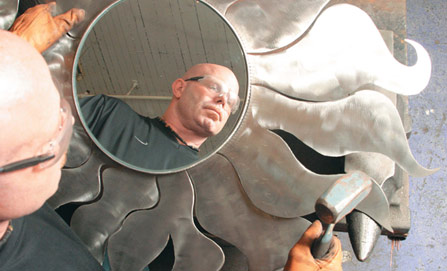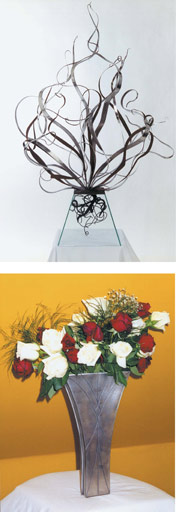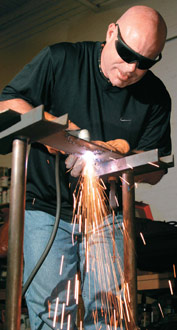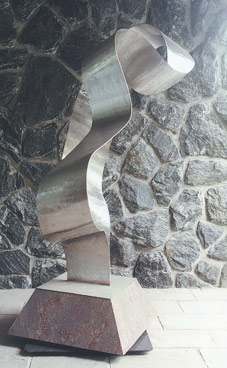 |
 |
||||||
Toronto’s man
of steel By Ffion Llwyd-Jones They have to see this! I have to show this! If I get a rush from this piece, then I want to share it so they can too.”A comment that typifies the passion that drives this man who creates images and ideas in steel. I meet Gregory Robins inside a large warehouse space in a less salubrious part of Toronto. Apprehensive from the grungy, utilitarian outside appearance, I am amazed to step through a heavy metal door into a white-painted, light space with soaring ceiling, gentle candles, and the tinkling, relaxing sound of a water fountain. Robins has made this space into his home and workplace, and it resonates with his ideas and passion. The rear of the space is his work area—a utilitarian grey space of metal, machinery, and machined forms—but with an old-fashioned clock on the wall, a correctly positioned horseshoe (“yes, I am a bit superstitious”he admits) and a poem written by his father, for his mother, framed on the wall.
His work encompasses functional and non-functional. Walking back into his living space, Robins points to an intricate, curving metal screen: “That was my first art show piece—it won an award.” Born and raised in Steeltown—Hamilton, Ont.—Robins grew up in an adopted family, with a steelworker father, stay-at-home mom, and younger brother. He did well at sports, but says he never excelled academically. But, “my school reports always read ‘he has to concentrate on art, he’s excelling in art.’” Leaving school at 18, he was twice accepted to Sheridan College—and twice turned the offer down. He says, “I didn’t know where I was going”and left his art for a while, working in odd jobs, mostly construction. But “the art was always there - and the drive got stronger and stronger”, and in 1996, he started his own business, combining his steel fabrication and his art. He considers himself “self-taught”and says that being adopted, “made me feel somewhat alone”. In 1998, after the death of his adoptive mother, he traced his birth family and found that his biological mother is a landscape painter, two brothers are photographers, and a third is a welder. “Finding my birth family made me feel in place, and gave me strength. I felt not so alone, that I had more, I wasn’t so lonely.”From Steeltown, Robins moved to Toronto. “I realized Hamilton wasn’t the place I wanted to be—I’d been at shows in Toronto before moving here. I knew I had to be here—more to help me develop and collaborate with other artists than anything else.” Describing that collaboration with other artists, he becomes passionate, describing in faster and faster talk (and his speech is usually considered) how ideas go back and forth, then, “Suddenly we’re saying yes! That’s it!”He grins, reliving the moment—passionately alive, intensely joyful. He goes with his gut feeling when it comes art, likes to feel the passion and excitement, the challenge. “That’s what drives me,”he adds. “Customers rely on me, the same with friends and family. Sometimes it’s difficult to separate living and working.”In Toronto, Robins feels there is “a better understanding of art compared to Hamilton, and there are so many doors that can open. I enjoy the environment in Toronto, the people, the dress, and the look.”
Functional pieces include antique-style steel beds, decorative screens and imaginative coffee tables. Ornamental pieces would include the steel grass sculpture, which sings as the wind moves through it, and a metal bowl he created in memory of a client’s dead sister. Recalling his client’s intense emotional reaction to that bowl, Robins comments, “You’re making something and you have no idea how you’re going to touch somebody.”He is involved with the 12th year of The Junction Arts Festival, a September event including a juried art show, live musical performances, dancers, poetry readings, interactive demonstrations and workshops. He’s also creating a decorative metal train as a free commission for his friend George Chuvalo (Fight Against Drugs), in memory of his wife. Ultimately, he says, “I’d love to be able to design and have people working with me, have a design school.”And in typical Gregory Robins fashion, he adds, “There’s not enough sharing out there—people sharing what they feel.”Leaving Robins’home/work space, I realize the inside of the heavy metal door is covered with one-cent pieces. Responding to my comment that it would take a long time to stick all those pieces up there, he says “Well, I soon got tired of doing that—that’s when I got help!”People, friends, sharing—components in the life of Gregory Robins, a self-sufficient man who takes joy in sharing his creativity, passion—and his intuitive interpretations of steel.
|


 Industrial
metal filters sit lined up on a workbench. Robins calls these
his “bread and butter”—the day job stuff that
gives him financial freedom to craft metal, take his customer’s
ideas and interpret them into unique designs. In the middle of
the floor sits a curved platform, with pink daisies encircling
the edge—it will be a child’s play/sleep area, covered
in soft, colourful cushions. A partially completed sign lies
waiting against the wall. They are symbols of Robins’ability
and skill to take a metal that is often thought of as cold, unyielding,
hard, and transform it into curving, polished, imaginative pieces.
Industrial
metal filters sit lined up on a workbench. Robins calls these
his “bread and butter”—the day job stuff that
gives him financial freedom to craft metal, take his customer’s
ideas and interpret them into unique designs. In the middle of
the floor sits a curved platform, with pink daisies encircling
the edge—it will be a child’s play/sleep area, covered
in soft, colourful cushions. A partially completed sign lies
waiting against the wall. They are symbols of Robins’ability
and skill to take a metal that is often thought of as cold, unyielding,
hard, and transform it into curving, polished, imaginative pieces.  His
work also shows inspiration drawn from Gothic and religious styles;
from architecture and past eras. “I enjoy working mostly
glass. The steel especially because of its strength, longevity
and weight. The piece at North York General hospital is stainless
steel, formed by hand. It’s very hard to do but I enjoy
the physical labour, and finding
His
work also shows inspiration drawn from Gothic and religious styles;
from architecture and past eras. “I enjoy working mostly
glass. The steel especially because of its strength, longevity
and weight. The piece at North York General hospital is stainless
steel, formed by hand. It’s very hard to do but I enjoy
the physical labour, and finding